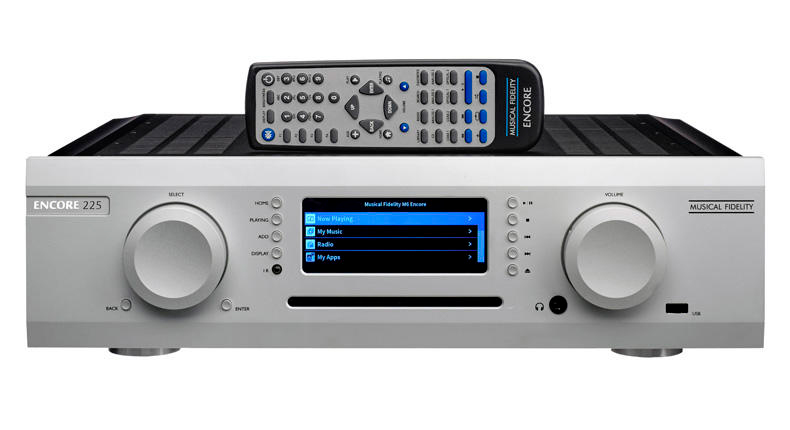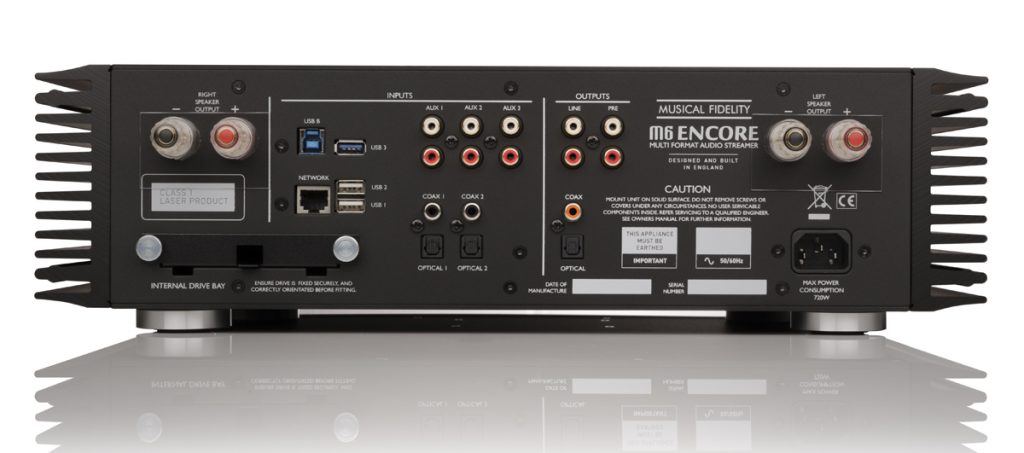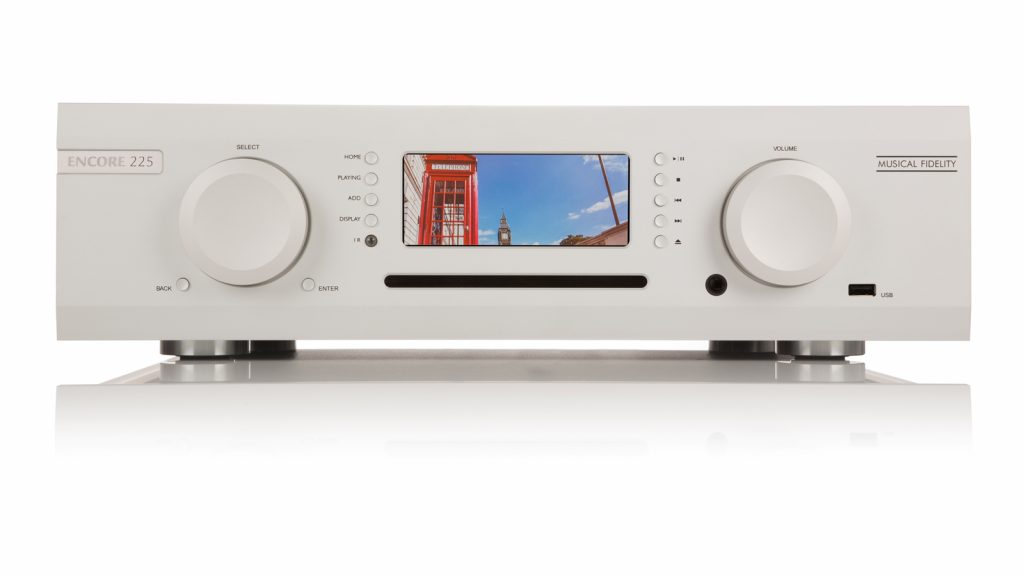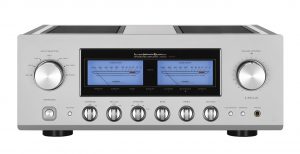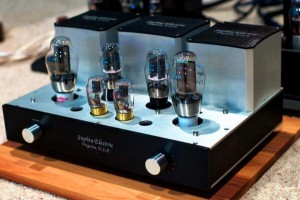A Distinguished Legacy
My use of, and admiration for, the expansive range of audio products from British manufacturer Musical Fidelity (recently purchased by none other than Heinz Lichtenegger, the director of Pro-Ject Audio Systems and a close friend of retiring Musical Fidelity head Antony Michaelson) dates back almost 20 years. In the late 1990s I owned a Musical Fidelity A220 integrated amp, a minimalist affair heavily biased into Class A that output a whopping 50 watts per channel into 8 Ohms, and 100 watts per channel into 4. Sweet and vibrant, what the little A220 lacked in raw horsepower it more than made up for in overall refinement, delicacy, and sonic purity. To this day, I regret parting with that little blast furnace (the bloody thing ran hot as hell).
Years later, I added a trio of Musical Fidelity's half-width X-series boxes, the X-DACv3, X-PSUv3, and X-10v3Tube Output Buffer, to my system. I did so to sweeten the sound of my then reference solid-state amp/preamp combo and long-in-the-tooth CD player. Those little boxes went a long way toward taming the sterile sound of the lower-priced solid-state gear I used at the time. I still have, and occasionally employ, these musical little gems.
Much has changed in the intervening years. For one, the best solid-state gear no longer requires a bit of sweetening from outboard tube buffers and the like, although some of the breed could certainly benefit from a little sweetening here and there. By the same token, speakers, cables, turntables, cartridges, and digital gear have all seen major sound quality improvements, although I will concede that a bit of this so-called "progress" has sometimes come at the expense of overall naturalness, midrange warmth, tonal richness, and the ability to capture realistically the myriad micro-dynamic modulations that make the best recording sound like music.
Not so Musical Fidelity. To my ears, the brand has never prioritized the preternatural retrieval of recorded detail over other metrics, particularly full-bodied tonality and truth of timbre. Soon-to-retire head honcho Anthony Michaelson, along with his creative design team, have instead produced amps and source components that, by and large, successfully amalgamate solid state precision, frequency extension, and dynamic slam with just the right touch of tube liquidity, tactility, and naturalness. The team is renowned for the use of rare Cold War-era "Nuvistor" input tubes in their upmarket Nu-Vista range of tube/solid-state hybrid amps, preamps, and associated source components, and justly so. Refreshingly, especially for budget-minded music lovers, the firm’s lower-priced offerings still manage to deliver large doses of the musical qualities that make the Nu-Vista range so engaging sonically.
Enter the relatively new, physically brawny M6 Encore 225 integrated amplifier ($5999/US with built-in CD player/music server/DAC modules), a far more sophisticated device than the MF gear I previously used, and which comes my way courtesy of John Bevier of Audio Plus Services (APS). As I reported back in Issue 96, John surmised that my reference Focal Sopra No. 1 compact speakers would pair felicitously with the lushly voiced Encore, and brother, was he ever right!
Heavily biased into Class A operation and hot-running (much like the long-discontinued A220), but sans the tiny Nuvistor tubes that separate the firm's signature electronics from their lower priced brethren, the Encore added a dash of warmth and bloom to the sound of the 1 (and to every other speaker I paired it with) that proved downright addictive.
The Encore delivers a commanding 225 w/p/c into 8 Ohms, and overall sounds a bit more relaxed and full-bodied than my reference Parasound JC 2 linestage/Bryston 4B³ stereo power amplifier combo. The Encore effectively transformed the 1 from a slightly lean compact into one that sings with a much more colorful and tonally expressive voice. Ditto the superb Von Schweikert UniField 2 Mk. III compacts that also serve as long term references here at Casa Jeffries. If your system sounds overly-analytical or bright, the Encore might prove just the remedy for what ails you.
On the other hand, and much to my surprise, my reference Maggie 1.7i planar speakers clearly preferred the added power, precision, and control that my reference amps deliver, the panels sounding a bit malnourished dynamically when driven by the Encore.
As always, proper matching of electronics to speakers is paramount to getting the best sound your system can deliver.
Pumping Iron
Attractively styled, clean-edged, and easy-to-use, the ruggedly-built Encore tips the scales at a robust 40 pounds, give or take a bit. The front panel features a large, centrally-located display screen, a large, round input selector controller to the left of the screen (when facing the unit), and a large, round volume controller to screen right. To the left and right of the display screen, but before the input and volume control knobs, sit two rows of vertically arranged push-buttons. The right row of buttons allows users to play, pause, fast forward, and reverse the content of CDs and digital music files manually. The left row takes users to the display screen home page, highlights digital music tracks currently playing, and permits navigation to the various screen pages projected onto the display panel.
All unit functions are accessible with the included plastic remote control. A downloadable app replicates these functions on your tablet or smart-phone. The Encore software supports both Apple and Android devices.
The busy rear panel boasts three RCA inputs, 2 coaxial digital inputs, 2 optical digital inputs, a USB digital input (over which one can stream DSD content), and an Ethernet port (necessary to boot up the Encore's operating software and to operate the unit's on-board digital music server). An IEC power inlet plus high-quality five-way speaker binding posts round out the package. Generous external heat-sinks adorn the amp's exterior. Coupled with the unit’s attractive brushed aluminum front panel, the Encore screams to the world that it means business.
Operational Quirks
I discovered three, none deal breakers.
On two separate occasions, after unsuccessfully attempting to power up the unit, I discovered that the only way to set things straight was to force a software re-boot. Unplugging the power cord feeding the unit and reinserting it after several seconds initiates the re-boot sequence (a three or four-minute cycle), after which time the Encore resumes normal operations. Please note that the ethernet cable must be connected to the Encore for the re-boot to occur. The unit's operating software automatically prompts the onboard processor to search the web for recent firmware updates, an essential aspect of the re-boot cycle.
Compact disc playback (and CD rips to the Encore's internal hard drive) also proved slightly idiosyncratic, if not outright annoying. In default mode, inserting a CD into the front panel slot initiates the rip function. In "rip" mode, the Encore processor/server downloads the CD's digital content to the unit's internal hard drive and searches the web for associated metadata. Once found, the server encodes the music file with associated metadata content (art work, title, etc.) to complete the file. I found the MF app reasonably effective overall, but the system failed to detect metadata content with roughly 20% of the CDs I ripped to the internal hard drive (around 20 or so). To play a CD, simply select "CD player" from the Main Menu and insert the disc into the Encore to commence standard CD playback.
Lastly, the volume control knob dislodged soon after the unit arrived here at Casa Jeffries. The knob appears to have been glued into place to secure it to the steel gain stem, not an arrangement I would have chosen or expected given the Encore's price, but one that I have seen used on other high-end units. However, I don't think poor construction is to blame here. Instead, I think bad weather may have played a part. You see, the APS folks shipped the unit to me from icy Canada, where temperatures hovered near zero.
By the time I took delivery of the Encore here in Central Florida in mid-winter (yes, this review has taken way too long), temperatures had soared into the 70s. I suspect that the warm, muggy Florida weather loosened the volume control adhesive just enough to allow the knob to pop off when I attempted to adjust playback levels manually. In any event, I ended up using the supplied full-function remote for the duration of this review. Still, Musical Fidelity should investigate matters further, if for nothing else than to rule out possible QC problems as the culprit.
Sweet Science
Having lived with the A220 for several years, the first aspect of the Encore's sound that caught my ear was the degree to which it mirrored, at least in broadest strokes, the overall sonic balance of its long-discontinued predecessor. Full-bodied, smooth, relaxed, and highly inviting (what John Bevier described over the phone to me as "lush"), the Encore boasted those signature qualities one routinely associates with amps heavily biased into Class A operation: generous doses of liquidity, sonic purity, and tonal richness. These qualities stood out regardless of musical genre, and regardless of my chosen playback medium (server, CD, SACD, or vinyl).
Like most of the Class A solid-state units I have spent time with over the years, and not unlike a very good tube amp, the Encore's sonic magic resides in the all-important midrange. Given firm founder Antony Michaelson's background as a classical clarinetist, this sonic prioritization makes perfect sense. An amplifier unable to reproduce accurately the timbre and unique tonal shadings of clarinets, oboes, saxophones etc., is unlikely to satisfy the musical sensibilities of someone like Mr. Michaelson.
As expected, the Encore excels in the reproduction of the all-important mid-register. Take something like the late tenor saxophonist Joe Henderson's standout Verve recordings from the early to mid-1990s as a starting point. Henderson's signature sound wed earthy soulfulness to the wispy angularity that almost all post-Coltrane tenor players embraced, at least to some degree, from the early 60s on. When challenged with something wispy and lyrical like Antonio Carlos Jobim's imminently hummable "Photograph" from the saxophonist's Grammy nominated 1995 release Double Rainbow (Verve), the Encore captured the sweet and sour bite of Henderson's tenor and his signature airy mastery of harmonic overtones to stunning effect. Without ambiguity, one could both sense and hear the fluttering of moist air through the saxophone mouthpiece, Joe's delicate fingerings along with the associated "plop" of leather key pads against the instrument’s brass tone holes, and the billowing waves of sound that bloomed almost like liquid out of the tenor bell.
Despite its unfailing midrange delicacy, warmth, and liquidity the Encore was not able to banish entirely to the sonic ether the persistent Blue Note "tizzy" piano glare that remains, now and forever, part and parcel of Rudy Van Gelder's sonic legacy (and which, love it or hate it—I’m somewhere in the middle—is not a figment of some biased anti-analogue conspiracy). The Encore did, however, go some way toward taming that persistent coloration. What the Encore managed to capture, and quite convincingly on my 45-rpm recording of Lee Morgan's The Sidewinder (Blue Note/Acoustic Sounds), was pianist Barry Harris's deft sense of touch, charm, and finesse, certainly when compared to the sound reproduced by my reference Parasound JC 2/Bryston 4B³ combo, while assiduously preserving all that was, and is, good and bad about this classic Blue Note release.
Voices also benefitted from the Encore's delicate midrange balance. I've recently fallen hard for the plaintive musings of singer Melody Gardot. Her dark, sultry voice serves as the perfect vehicle for the soulful jazz-pop musings she prefers musically, many introspective reflections on broken relationships and love lost and found. The innate sweetness of the Encore, its liquid purity, and genuine truth of vocal and instrumental timbre all served her voice, and the music, sublimely. Just check out Gardot's superb 2009 release My One and Only Thrill (Verve), particularly the mournful ballad "The Rain," to see/hear what I mean! The sense of 3D palpability on display was positively eerie.
Image by Maurice Jeffries
The Encore also handled the frequency extremes convincingly. Highs shimmered sweetly, totally without grit or grain. Early compact discs, with their bleached tonality, piercing highs, and overall dark balance, benefited from this subtle sweetening, as did more recent digital recordings. What the Encore added never, at least in my humble opinion, detracted from the deeper musical message. By the same token, what one will not get is the lightening-quick transient speed, preternatural extension, clarity, and sheer transparency that one hears (or not) with the three-times as pricey Audionet WATT integrated amp that I reviewed in Issue 96 (HERE). What the WATT delivers is a kind of colorlessness that paradoxically draws out instrumental colors, tonal shadings, and fine textures from the recording in stark relief.
Down low, the Encore also did not disappoint. Tuneful, rich, and beautifully extended, the lower registers bellowed with an almost liquid density. Instrumental timbres sounded extraordinarily true-to-life, especially woodwinds, acoustic bass, and low brass. Returning once again to my 45-rpm recording of trumpeter Lee Morgan's The Sidewinder, the Encore delivered intact Bob Crenshaw's taut, textured bass lines, each rich with micro-dynamic bounce and just enough overall dynamic punch to satisfy solid-state fans.
In absolute terms, while the Encore does add a bit of color, warmth, and body to the musical proceedings, it never does so in a heavy-handed or objectionable way.
As a side-note, the combination of the Encore amp/server and the Sutherland 20/20 phono preamp I have in-house (review forthcoming), paired remarkably well. The Encore's inherent "lushness" worked a charm when fed by the ever-so-slightly lean (but also beautifully detailed and naturally voiced) 20/20 phono-stage. In unison, the two solid-state units successfully secured the sonic middle ground, combining natural instrumental warmth with an infectiously detailed directness that I really enjoyed. Vinyl fans who own, or are considering, a Musical Fidelity amp should also consider a Sutherland phono preamp. I found the paring to be a match made in heaven.
So Many Servers, So Little Time
For the bulk of this review, I used the Encore's onboard server/DAC combo. The combined sound essentially mirrored what I described above. The DAC sounded very fine indeed, deftly fusing warmth and roundness of presentation with sufficient detail retrieval to avoid sonic homogenization. The key question I wanted to sort out during the review cycle was whether the onboard DAC/server combo could run toe-to-toe with pricier outboard units. Confronted with the outsized performance of my reference DAC/server combo, the onboard Musical Fidelity pair held up exceptionally well. The onboard units rivaled my references for ease-of-use and offered equal doses of musical warmth and involvement.
The reference units ultimately pulled ahead of the on board modules in their ability to exhume the finest musical details, tonal shadings, and dynamic contrasts from each file they played. But the sonic differences between the two setups proved way too close for comfort.
To put this into perspective, please bear in mind that the reference combo (with digital cables and interconnects) costs roughly $5K, almost the price of the entire Encore package. When one factors in the genuine single-box convenience of the M6 (obviating the need for expensive digital and interconnect cables), the ability to play digital files and CDs seamlessly, plus the overall excellent sonics, then the Encore begins to look (and sound) like quite the total package, and a damn fine bargain to boot.
Here's my advice, especially if you live in cramped quarters and value system simplicity: seek out an Encore dealer who can demo the unit sympathetically. If you're sold, add a pair of great stand-mounts to round out the package. The Focal Sopra 1s and the VSA UniField 2 Mk. III compacts that I use as references are great places to start, but pricey. For a lot less scratch, the Studio Electric M4s (starting at $2100 the pair plus stands), the B&W 705 s2s ($2500 the pair plus stands), or the superb Harbeth P3ESR mini-monitors (around $2300 a pair depending on exchange rates, plus stands) would all fit the bill nicely. Throw in a turntable and decent phono preamp if you must, some decent speaker cables, plus a good after-market power cord for the M6, and friend, you are in the game.
Very, very highly recommended!
Musical Fidelity M6 Encore 225 Integrated Amplifier
Retail: $5999
U.S. Distributor
Audio Plus Services
156 Lawrence Paquette Ind. Dr.
Champlain, NY 12919
United States
800.663.9352
All images courtesy of Musical Fidelity unless otherwise noted.




